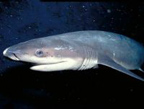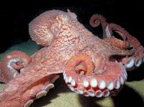What’s Moving Under Our Waters
Courtesy of John Frawley, Aquarium of the
bay
 |
| Sevengill sharks live in the
more shallow waters along the Pacific Coast.
|
The San Francisco Bay watershed
constitutes an area that includes over 40 percent of
California and extends into Oregon.
Nearly 400 billion gallons of water flows through the
Golden Gate Strait each day, due to the Pacific’s strong
rising and falling tides.
Great White Sharks (Carcharodon carcharias) rarely
enter the San Francisco Bay, because they prefer the saltier
waters of the Pacific Ocean.
Wolf-eels (Anarrhichthys ocellatus) mate for life. They
dwell in small, rocky caves and feed at night.
Sevengill Sharks (Notorynchus cepedianus) have seven
gill slits (most sharks have five) and can grow to 7 feet in
length.
 |
| The Giant Octopus lives in
the Pacific. Sailors used to call them
“devilfish,” even though they are not dangerous
and usually shy away from humans. |
Giant Octopus (Enteroctopus dofleini)
live in the Pacific Ocean and can grow to be 30 feet long -
that’s a 15-foot tentacle span!
Leopard Sharks (Triakis semifasciata) feed on species
living on the bottom of the ocean. An abundant number live
in the Bay.
Some invertebrates that live in the tide pools can
live without being in water for up to 12 hours.
Male Bay Pipefish (Syngnathus
leptorhynchus), cousin to the seahorse, hold their eggs
in a pouch until they hatch.
 |
| Leather sea stars are
actually smooth, and are rumored to smell like
garlic. |
Sea Stars (Echinodermata asteroidea)
can regenerate a lost arm, or even two!